Toyota BZ4X 2023 Essential Information User Guide
In the 2023 Toyota BZ4X, protecting your safety and well-being in unexpected situations is very important. To drive with confidence, you need to know what information you need and what steps to take in an emergency. The BZ4X is more than just an innovative electric engine and cutting-edge technology. It also cares about your safety, whether you’re driving in the city or going on an adventure. This cutting-edge electric SUV gives drivers the tools they need to handle both life-threatening and non-life-threatening situations with poise and readiness. They can call 911 right away to get help, and Toyota offers dedicated customer service and roadside assistance. When you need to move quickly, knowing the right people to call and the right steps to take can make all the difference. This shows that Toyota is committed to both sustainable mobility and your peace of mind in the 2023 BZ4X.
2023 toyota BZ4x Specs, Price, Features and Mileage (Brochure)
Emergency flashers
The emergency flashers are used to warn other drivers when the vehicle has to be stopped in the road due to a breakdown, etc.
Operating instructions
Press the switch.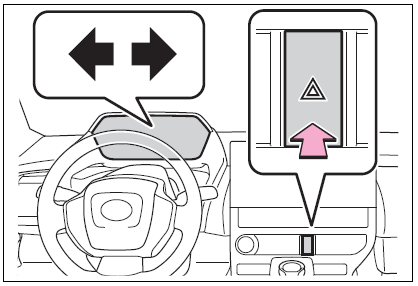
All the turn signal lights will flash. To turn them off, press the switch once again.
Emergency flashers
- If the emergency flashers are used for a long time while the EV system is not operating (while the “READY” indicator is not illuminated), the 12-volt battery may discharge.
- If any of the SRS airbags deploy (inflate) or in the event of a strong rear impact, the emergency flashers will turn on automatically.
- The emergency flashers will turn off automatically after operating for approximately 20 minutes.
- To manually turn the emergency flashers off, press the switch twice.
- (The emergency flashers may not turn on automatically depending on the force of the impact and conditions of the collision
If your vehicle has to be stopped in an emergency
Only in an emergency, such as if it becomes impossible to stop the vehicle in the normal way, stop the vehicle using the following procedure:
Stopping the vehicle
- Steadily step on the brake pedal with both feet and firmly depress it.
- Shift the shift position to N.
- After slowing down, stop the vehicle in a safe place by the road.
- Stop the EV system.
- Keep depressing the brake pedal with both feet to reduce vehicle speed as much as possible.
- To stop the EV system: Press and hold the power switch for 2 consecutive seconds or more, or press it briefly 3 times or more in succession
- Stop the vehicle in a safe place by the road.
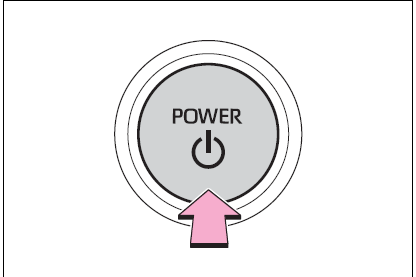
WARNING
If the EV system has to be turned off while driving Turning the EV system off while driving will not cause a loss of steering or braking control. However, power assist for the steering wheel may be lost making it difficult to steer smoothly before stopping the vehicle depending on the remaining charge in the 12-volt battery or usage conditions. Decelerate as much as possible before turning off the EV system
If the vehicle is submerged or water on the road is rising
This vehicle is not designed to be able to drive on roads that are deeply flooded with water. Do not drive on roads where the roads may be submerged or the water may be rising. It is dangerous to remain in the vehicle, if it is anticipated that the vehicle will be flooded or set a drift. Remain calm and follow the following.
- If the door can be opened, open the door and exit the vehicle.
- If the door can not be opened, open the window using the power window switch and ensure an escape route.
- If the window can be opened, exit the vehicle through the window.
- If the door and window cannot be opened due to the rising water, remain calm, wait until the water level inside the vehicle rises to the point that the water pressure inside of the vehicle equals the water pressure outside of the vehicle and then open the door after waiting for the rising water to enter the vehicle, and exit the vehicle. When the outside water level exceeds half the height of the door, the door cannot be opened from the inside due to water pressure.
Water level exceeds the floor
When the water level exceeds the floor and time has passed, the electrical equipment will get damaged, the power windows will not operate, the motor stop, and the vehicle may not be able to get moving.
Using an emergency escape hammer
Laminated glass is used in the windshield on this vehicle. Laminated glass cannot be shattered with an emergency hammer. Tempered glass is used in the windows on this vehicle.*: Contact your Toyota dealer or aftermarket accessory manufacturer for further information about an emergency hammer.
WARNING
- Caution while driving
- Do not drive on roads where the roads may be submerged or the water may be rising.
- Otherwisethe vehicle may be damaged and cannot move, as well as become flooded and set a drift, which may lead to death.
If your vehicle needs to be towed
If towing is necessary, we recommend having your vehicle towed by your Toyota dealer or commercial towing service, using a wheel-lift type truck or flatbed truck. Use a safety chain system for all towing, and abide by all state/ provincial and local laws.
Situations when it is not possible to be towed by another vehicle
In the following situations, it is not possible to be towed by another vehicle using cables or chains, as the front wheels may be locked due to the parking lock. Contact your Toyota dealer or commercial towing service.
- There is a malfunction in the shift control system.
- There is a malfunction in the immobilizer system.
- There is a malfunction in the smart key system.
- The 12-volt battery is discharged.
Situations when it is necessary to contact dealers before towing
The following may indicate a problem with your transmission. Contact your Toyota dealer or commercial towing service before towing.
- The EV system warning message is shown on the multi-information display and the vehicle does not move.
- The vehicle makes an abnormal sound.
Towing with a wheel-lift type truck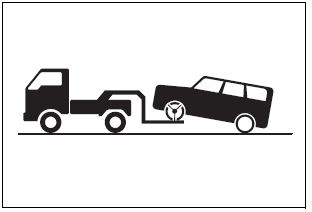
From the front (2WD models)
Release the parking brake. Turn the automatic mode off.
From the front (AWD models)
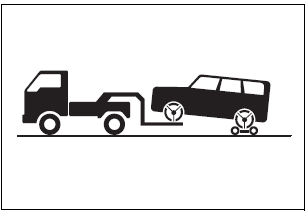
From the rear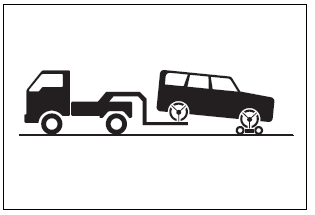
WARNING
- Observe the following precautions.
- Failure to do so may result in death or serious injury.
When towing the vehicle
2WD models
Be sure to transport the vehicle with the front wheels raised or with all four wheels raised off the ground. If the vehicle is towed with the front wheels contacting the ground, the drivetrain and related parts may be damaged or electricity generated by the operation of the motor may cause a fire to occur depending on the nature of the damage or malfunction.
WARNING
AWD models
Be sure to transport the vehicle with all four wheels raised off the ground. If the vehicle is towed with the tires contacting the ground, the drivetrain or related parts may be damaged, the vehicle may fly off the truck, or electricity generated by the operation of the motor may cause a fire to occur depending on the nature of the damage or malfunction. 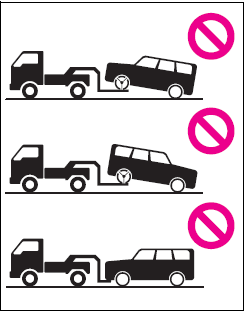
NOTICE
To prevent damage to the vehicle when towing using awheel-lift type truck When raising the vehicle, ensure adequate ground clearance fortowing at the opposite end of the raised vehicle. Without adequate clearance, the vehicle could be damaged while being towed.
Towing with a sling-type truck
Do not tow with a sling-type truck to prevent body damage.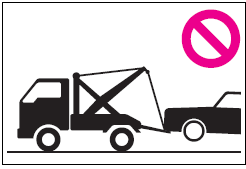
Using a flatbed truck
When using a flatbed truck to transport the vehicle, use tire strapping belts. Refer to the owner’s manual of the flatbed truck for the tire strapping method. In order to suppress vehicle movement during transportation, set the parking brake and turn the power switch off.
Emergency towing
If a tow truck is not available in an emergency, your vehicle may be temporarily towed using cables or chains secured to the emergency towing eyelets. This should only be attempted on hard-surfaced roads for short distances at under 18 mph (30 km/h). A driver must be in the vehicle to steer and operate the brakes. The vehicle’s wheels, drive train, axles, steering and brakes must be in good condition.
Emergency towing procedure
To have your vehicle towed by another vehicle, the towing eyelet must be installed to your vehicle. Install the towing eyelet using the following procedure.
- Take out the wheel bolt wrench and tow eyelet.
- Remove the eyelet cover using a flathead screwdriver.

- To protect the bodywork, place a rag between the screwdriver and the vehicle body as shown in the illustration. Insert the towing eyelet into the hole and tighten partially by hand.
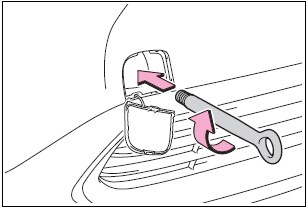
- Tighten down the towing eyelet securely using a wheel bolt wrench or hard metal bar.

- Securely attach cables or chains to the towing eyelet. Take care not to damage the vehicle body.
- Enter the vehicle being towed and start the EV system. If the EV system does not start, turn the power switch to ON.
- Shift the shift position to N and release the parking brake.
While towing
- If the EV system is off, the power assist for the brakes and steering will not function, making steering and braking more difficult.
- Wheel bolt wrench Wheel bolt wrench is installed in luggage compartment.
WARNING
- Observe the following precautions.
- Failure to do so may result in death or serious injury.
WARNING
While towing
- When towing using cables or chains, avoid sudden starts, etc., which place excessive stress on the towing eyelets, cables or chains. The towing eyelets, cables or chains may become damaged, broken debris may hit people, and cause serious damage.
- Do not perform any of the following as doing so may cause the parking lock mechanism to engage, locking the front wheels and possibly leading to an accident resulting in death or serious injury: • Unfasten the driver’s seat belt and open the driver’s door.
- Turn the power switch off.
- Installing towing eyelets to the vehicle Make sure that towing eyelets are installed securely. If not securely installed, towing eyelets may come loose during towing.
NOTICE
To prevent damage to the vehicle during emergency towing Do not secure cables or chains to the suspension components.
If you think something is wrong
If you notice any of the following symptoms, your vehicle probably needs adjustment or repair. Contact your Toyota dealer as soon as possible.
Visible Symptoms
- Fluid leaks under the vehicle.
(Water dripping from the air conditioning after use is normal.) - Flat-looking tires or uneven tire wear
- Engine coolant temperature gauge needle continually points higher than normal.
Audible symptoms
- Changes in exhaust sound
- Excessive tire squeal when cornering
- Strange noises related to the suspension system
- Pinging or other noises related to the engine
Operational symptoms
- Engine missing, stumbling or running roughly
- Appreciable loss of power
- Vehicle pulls heavily to one side when braking
- Vehicle pulls heavily to one side when driving on a level road
- Loss of brake effectiveness, spongy feeling, pedal almost touches the floor
If a warning light turns on or a warning buzzer sounds
Calmly perform the following actions if any of the warning lights come on or flashes. If a light comes on or flashes, but then goes off, this does not necessarily indicate a malfunction in the system. However, if this continues to occur, have the vehicle inspected by your Toyota dealer.
Actions to the warning lights or warning buzzers
Brake system warning light (warning buzzer)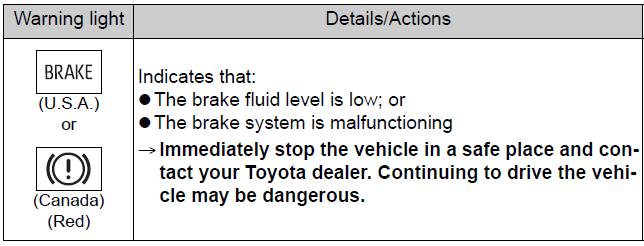
Brake system warning light

Charging system warning light*

SRS warning light (warning buzzer)

Inappropriate pedal operation warning light* (warning buzzer)
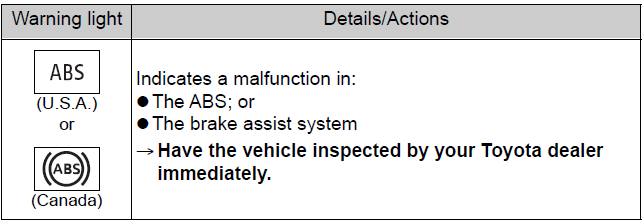
Electric power steering system warning light (warning buzzer)
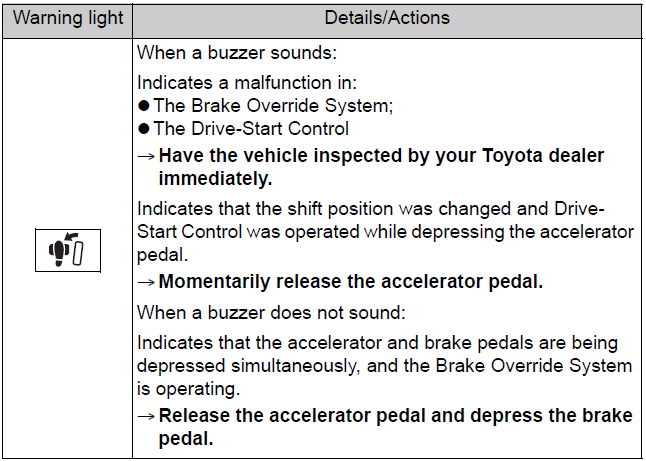
Traction battery charge warning light
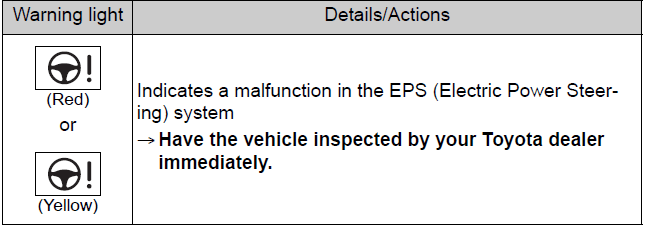
Driver’s and front passenger’s seat belt reminder light (warning buzzer*)
Driver’s and front passenger’s seat belt warning buzzer:
The driver’s and front passenger’s seat belt warning buzzer sounds to alert the driver and front passenger that his or her seat belt is not fastened. If the seat belt is unfastened, the buzzer sounds intermittently for a certain period of time after the vehicle reaches a certain speed.
Rear passengers’ seat belt reminder lights (warning buzzer*)
Rear passengers’ seat belt warning buzzer:
The rear passenger’s seat belt warning buzzer sounds to alert the rear passenger that his or her seat belt is not fastened. If the seat belt is unfastened, the buzzer sounds intermittently for a certain period of time after the vehicle reaches a certain speed.
Tire pressure warning light
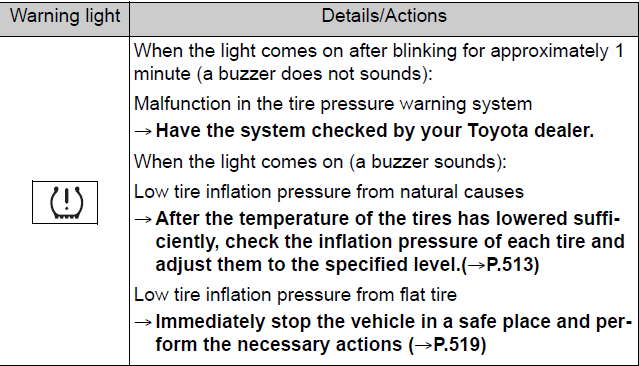
LDA indicator (warning buzzer)

LTA indicator (warning buzzer)
Driving assist information indicator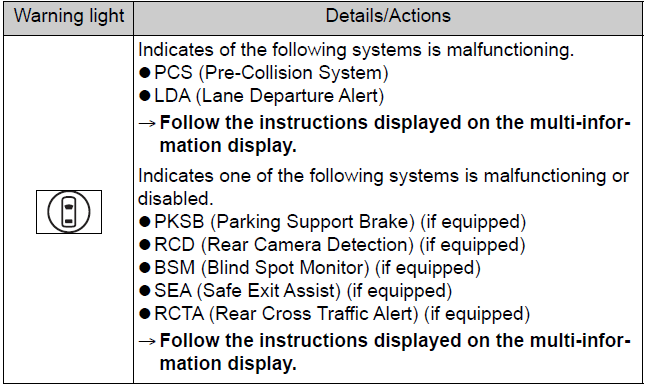
Intuitive parking assist OFF indicator (warning buzzer)
Cruise control indicator (warning buzzer)
Dynamic radar cruise control indicator (warning buzzer)
PCS warning light (warning buzzer)

Slip indicator

Parking brake indicator

Brake hold operated indicator

Warning buzzer
In some cases, the buzzer may not be heard due to being in a noisy location or audio sound.
- Front passenger detection sensor, seat belt reminder and warning buzzer
- If luggage is placed on the front passenger seat, the front passenger detection sensor may cause the warning light to flash and the warning buzzer to sound even if a passenger is not sitting in the seat.
- If a cushion is placed on the seat, the sensor may not detect a passenger, and the warning light may not operate properly.
SRS warning light
This warning light system monitors the airbag sensor assembly, front impact sensors, side impact sensors (front door), side impact sensors (front), side impact sensors (rear), driver’s seat position sensor, driver’s seat belt buckle switch, front passenger occupant classification system sensors, “AIR BAG ON” indicator light, “AIR BAG OFF” indicator light, front passenger’s seat belt buckle switch, seat belt pretensioners, airbags, interconnecting wiring and power sources
Electric power steering system warning light (warning buzzer)
When the 12-volt battery charge becomes insufficient or the voltage temporarily drops, the electric power steering system warning light may come on and the warning buzzer may sound. When the tire pressure warning light comes on Inspect the tires to check if a tire is punctured. If a tire is punctured: If none of the tires are punctured: Turn the power switch off then turn it to ON. Check if the tire pressure warning light comes on or blinks.
If the tire pressure warning light blinks for approximately 1 minute then stays on There may be a malfunction in the tire pressure warning system. Have the vehicle inspected by your Toyota dealer immediately.
If the tire pressure warning light comes on
1 After the temperature of the tires has lowered sufficiently, check the inflation pressure of each tire and adjust them to the specified level.
2 If the warning light does not turn off even after several minutes have elapsed, check that the inflation pressure of each tire is at the specified level and perform the tire inflation pressure setting procedure.
If the warning light does not turn off even after several minutes have elapsed since performing the tire inflation pressure setting procedure, have the vehicle inspected by your Toyota dealer as soon as possible. The tire pressure warning light may come on due to natural causes The tire pressure warning light may come on due to natural causes such as natural air leaks and tire inflation pressure changes caused by temperature. In this case, adjusting the tire inflation pressure will turn off the warning light (after a few minutes).
Conditions that the tire pressure warning system may not function properly
- This light illuminates on the multi-information display.
- Parking brake engaged warning buzzer: A buzzer will sound if the vehicle is driven at a speed of approximately 3 mph (5 km/h) or more.
- Vehicles with 215/55R17 tires
- Driver’s seat belt buzzer:
- The driver’s seat belt warning buzzer sounds to alert the driver that his or her seat belt is not fastened. Once the engine switch is turned to IGNITION ON mode, the buzzer sounds. If the seat belt is still unfastened, the buzzer sounds intermittently for a certain period of time after the vehicle reaches a certain speed. Front passenger’s seat belt buzzer: The front passenger’s seat belt warning buzzer sounds to alert the front passenger that his or her seat belt is not fastened. If the seat belt is unfastened, the buzzer sounds intermittently for a certain period of time after the vehicle reaches a certain speed.
- Rear passenger’s seat belt buzzer:
- The rear passenger’s seat belt warning buzzer sounds to alert the rear passenger that his or her seat belt is not fastened. If the seat belt is unfastened, the buzzer sounds intermittently for a certain period of time, after the seat belt is fastened and unfastened and the vehicle reaches a certain speed
WARNING
If both the ABS and the brake system warning lights remain on
- Stop your vehicle in a safe place immediately and contact your Toyota dealer. The vehicle will become extremely unstable during braking, and the ABS system may fail, which could cause an accident resulting in death or serious injury.
When the electric power steering system warning light comes on
- When the light comes on yellow, the assist to the power steering is restricted. When the light comes on red, the assist to the power steering is lost and handling operations of the steering wheel become extremely heavy. When steering wheel operations are heavier than usual, grip the steering wheel firmly and operate it using more force than usual.
If the tire pressure warning light comes on
- Be sure to observe the following precautions. Failure to do so could cause a loss of vehicle control and result in death or serious injury.
- Stop your vehicle in a safe place as soon as possible. Adjust the tire inflation pressure immediately.
- If the tire pressure warning light comes on even after tire inflation pressure adjustment, it is probable that you have a flat tire. Check the tires. If a tire is flat, change it with the spare tire and have the flat tire repaired by the nearest Toyota dealer.
- Avoid abrupt manoeuvring and braking.
- If the vehicle tires deteriorate, you could lose control of the steering wheel or the brakes.
If a blowout or sudden air leakage should occur
- The tire pressure warning system may not activate immediately.
Maintenance of the tires
- Each tire, including the spare (if provided), should be checked monthly when cold and inflated to the inflation pressure recommended by the vehicle manufacturer on the vehicle placard or tire inflation pressure label (tire and load information label). (If your vehicle has tires of a different size than the size indicated on the vehicle placard or tire inflation pressure label [tire and load information label], you should determine the proper tire inflation pressure for those tires.)
WARNING
As an added safety feature, your vehicle has been equipped with a tire pressure monitoring system (TPMS-tire pressure warning system) that illuminates a low tire pressure telltale (tire pressure warning light) when one or more of your tires is significantly underinflated. Accordingly, when the low tire pressure telltale (tire pressure warning light) illuminates, you should stop and check your tires as soon as possible, and inflate them to the proper pressure. Driving on a significantly under-inflated tire causes the tire to overheat and can lead to tire failure. Under-inflation also reduces fuel efficiency and tire tread life, and may affect the vehicle’s handling and stopping ability. Please note that the TPMS (tire pressure warning system) is not a substitute for proper tire maintenance, and it is the driver’s responsibility to maintain correct tire pressure, even if under-inflation has not reached the level to trigger illumination of the TPMS low tire pressure telltale (tire pressure warning light). Your vehicle has also been equipped with a TPMS (tire pressure warning system) malfunction indicator to indicate when the system is not operating properly. The TPMS (tire pressure warning system) malfunction indicator is combined with the low tire pressure telltale (tire pressure warning light). When the system detects a malfunction, the telltale will flash for approximately one minute and then remain continuously illuminated. This sequence will continue upon subsequent vehicle start-ups as long as the malfunction exists. When the malfunction indicator is illuminated, the system may not be able to detect or signal low tire pressure as intended. TPMS (tire pressure warning system) malfunctions may occur for a variety of reasons, including the installation of replacement or alternate tires or wheels on the vehicle that prevent the TPMS (tire pressure warning system) from functioning properly. Always check the TPMS (tire pressure warning system) malfunction telltale after replacing one or more tires or wheels on your vehicle to ensure that the replacement or alternate tires and wheels allow the TPMS (tire pressure warning system) to continue to function properly.
NOTICE
- To ensure the tire pressure warning system operates properly
- Do not install tires with different specifications or makers, as the tire pressure warning system may not operate properly.
If a warning message is displayed
The multi-information display shows warnings of system malfunctions, incorrectly performed operations, and messages that indicate a need for maintenance. When a message is shown, perform the correction procedure appropriate to the message. If a warning message is displayed again after the appropriate actions have been performed, contact your Toyota dealer. Additionally, if a warning light comes on or flashes at the same time that a warning message is displayed, take the appropriate corrective action for the warning light.
Warning messages
The warning messages explained below may differ from the actual messages according to operation conditions and vehicle specifications.
Warning buzzer
In some cases, the buzzer may not be heard due to being in a noisy location or audio sound.
If “EV system stopped Steering power low” is displayed
This message is displayed if the EV system is stopped while driving. When steering wheel operations are heavier than usual, grip the steering wheel firmly and operate it using more force than usual.
If “EV system overheated Output power reduced” is displayed
This message may be displayed when driving under severe operating conditions. (For example, when driving up a long steep hill.) Handling method:
If “Shift System Malfunction Shifting Unavailable Drive to a Safe Place and Stop” or “Shift System Malfunction Driving Unavailable” is displayed
There is a malfunction in the shift control system. Have the vehicle inspected by your Toyota dealer immediately.
If “Shift is in N Release accelerator before shifting” is displayed
The accelerator pedal has been depressed when the shift position is in N. Release the accelerator pedal and shift the shift position to D or R.
If “Press brake when vehicle is stopped EV system may overheat” is displayed
The message may be displayed when the accelerator pedal is depressed to hold the vehicle while the vehicle is stopped on an incline, etc. The EV system may overheat. Release the accelerator pedal and depress the brake pedal.
If “Auto Power Off To Conserve Battery” is displayed
Power was turned off due to the automatic power off function. Next time when starting the EV system, operate the EV system for approximately 5 minutes to recharge the 12-volt battery.
If “Regenerative Braking Limited Press Brake to Decelerate” is displayed
Regenerative braking may be restricted in the following situations. Firmly depress the brake pedal to decelerate the vehicle.
- When electrical energy cannot be regenerated any more as the traction battery is fully charged
- When the temperature of the traction battery is extremely high or extremely low
When the temperature of the electric motor or power control unit, etc., is extremely high
If “High Power Consumption Power to Climate Temporarily Limited” is displayed
Turn off unnecessary electronic equipment to reduce power consumption. Please wait until the power supply returns to normal.
If “Headlight System Malfunction Visit Your Dealer” is displayed
The following systems may be malfunctioning. Have the vehicle inspected by your Toyota dealer immediately.
- The LED headlight system
- Automatic High Beam
If “System Malfunction Visit Your Dealer” is displayed Indicates one of the following systems is disabled.
- PCS (Pre-Collision System)
- LDA (Lane Departure Alert)
- LTA (Lane Tracing Assist)
- AHB (Automatic High Beam)
- Dynamic radar cruise control
- RSA (Road Sign Assist)
- BSM (Blind Spot Monitor) (if equipped)
- RCTA (Rear Cross Traffic Alert) (if equipped)
- SEA (Safe Exit Assist) (if equipped)
- Intuitive parking assist (if equipped)
- PKSB (Parking Support Brake) (if equipped)
- RCD (Rear Camera Detection) (if equipped)
Have the vehicle inspected by your Toyota dealer immediately.
If “System Stopped See Owner’s Manual” is displayed
Indicates one of the following systems is disabled.
- PCS (Pre-Collision System)
- LDA (Lane Departure Alert)
- LTA (Lane Tracing Assist)
- AHB (Automatic High Beam)
- Dynamic radar cruise control
- RSA (Road Sign Assist)
- BSM (Blind Spot Monitor) (if equipped)
- RCTA (Rear Cross Traffic Alert) (if equipped)
- SEA (Safe Exit Assist) (if equipped)
- Intuitive parking assist (if equipped)
- PKSB (Parking Support Brake) (if equipped)
- RCD (Rear Camera Detection) (if equipped)
Follow the following correction methods.
- Check the voltage of the battery
- Remove any dirt or foreign matter from the front/rear side radar sensors
If “System Stopped Front Camera Low Visibility See Owner’s Manual” is displayed
Indicates one of the following systems is disabled.
- PCS (Pre-Collision System)
- LDA (Lane Departure Alert)
- LTA (Lane Tracing Assist)
- AHB (Automatic High Beam)
- Dynamic radar cruise control
- RSA (Road Sign Assist)
Follow the following correction methods.
- Follow the following correction methods.
- Using the windshield wipers, remove the dirt or foreign matter from the windshield.
- Using the air conditioning system, defog the windshield.
Close the hood, remove any stickers, etc. to clear the obstruction in front of the front camera.
If “System Stopped Front Camera Out of Temperature Range Wait until Normal Temperature” is displayed
Indicates one of the following systems is disabled.
- PCS (Pre-Collision System)
- LDA (Lane Departure Alert)
- LTA (Lane Tracing Assist)
- AHB (Automatic High Beam)
- Dynamic radar cruise control
- RSA (Road Sign Assist)
Follow the following correction methods.
- If the front camera is hot, such as after the vehicle is parked in the sun, use the air conditioning system to decrease the temperature around the front camera
- If a sunshade was used when the vehicle was parked, depending on its type, the sunlight reflected from the surface of the sunshade may cause the temperature of the front camera to become excessively high
- If the front camera is cold, such after the vehicle is parked in an extremely cold environment, use the air conditioning system to increase the temperature around the front camera
If “System Stopped Front Radar Sensor Blocked Clean Radar Sensor” is displayed
Indicates one of the following systems is disabled.
- PCS (Pre-Collision System)
- LDA (Lane Departure Alert)
- LTA (Lane Tracing Assist)
- AHB (Automatic High Beam)
- Dynamic radar cruise control
- RSA (Road Sign Assist)
Follow the following correction methods.
- Check if there is any foreign matter attached to the radar sensor or radar sensor cover and clean them if necessary
- This message may be displayed when driving in an open area with few nearby vehicles or structures, such as a desert, grasslands, suburbs, etc.
The message may be cleared by driving the vehicle in an area with structures, vehicles, etc., nearby.
If “System Stopped Front Radar Sensor Out of Temperature Range Wait until Normal Temperature” is displayed
Indicates one of the following systems is disabled.
- PCS (Pre-Collision System)
- LDA (Lane Departure Alert)
- LTA (Lane Tracing Assist) AHB (Automatic High Beam)
- Dynamic radar cruise control
- RSA (Road Sign Assist) Follow the following correction methods.
The temperature of the radar sensor is outside of the operating range. Wait for the temperature to become appropriate.
If “System Stopped Front Radar In Self Calibration See Owner’s Manual” is displayed
Indicates one of the following systems is disabled.
- PCS (Pre-Collision System)
- LDA (Lane Departure Alert)
- LTA (Lane Tracing Assist)
- AHB (Automatic High Beam)
- Dynamic radar cruise control
- RSA (Road Sign Assist) Follow the following correction methods.
- Check if there is any foreign matter attached to the radar sensor or radar sensor cover and clean them if necessary
- The radar sensor may be misaligned and will be adjusted automatically while driving. Continue driving for a while.
If “Cruise Control Unavailable See Owner’s Manual” is displayed
Indicates one of the following systems is disabled.
- Dynamic radar cruise control
- Cruise control
- A message is displayed when the driving assist switch is pushed repeatedly.
- Press the driving assist switch quickly and firmly.
If a message that indicates the need to visit your Toyota dealer is displayed
- The system or part shown on the multi-information display is malfunctioning. Have the vehicle inspected by your Toyota dealer immediately.
If a message that indicates the need for the rotary shifter operation is displayed
To prevent the rotary shifter from being operated incorrectly or the vehicle from moving unexpectedly, a message that requires shifting the shift position may be displayed on the multi-information display. In that case, follow the instructions of the message and shift the shift position.
If a message that indicates the need to refer to the Owner’s Manual is displayed
- If any of the following messages are shown on the multi-information display, follow the instructions.
- “Battery Low”
- “Check Charging System Close Charging Port Lid”
- “Charging system malfunction
- “Charging stopped High energy use”
If any of the following messages are shown on the multi-information display, it may indicate a malfunction. Have the vehicle inspected by your Toyota dealer immediately.
- “Entry & Start System Malfunction”
- “Traction battery system malfunction”
- “Accelerator system malfunction”
- “Plug-in Charging System Malfunction”
- “EV system malfunction”
- “Shift System Malfunction Apply Parking Brake Securely When Parking See Owner’s Manual”
- “Shift System Malfunction See Owner’s Manual”
- “Shift System Malfunction Stop in a Safe Place See Owner’s Manual”
- “P Switch Malfunction Apply Parking Brake Securely When Parking See Owner’s Manual”
- “Shift System Unavailable Apply Parking Brake Securely When Parking See Owner’s Manual”
- “Battery Low Shifting Unavailable See Owner’s Manual”
If any of the following messages are shown on the multi-information display, it may indicate a malfunction. Immediately stop the vehicle and contact your Toyota dealer.
- “Braking Power Low”
NOTICE
- If “High Power Consumption
- Power to Climate Temporarily Limited” is displayed frequently
- There is a possible malfunction relating to the charging system or the 12-volt battery may be deteriorating.
- Have the vehicle inspected by your Toyota dealer.
- If “Battery Low” is displayed frequently
- The 12-volt battery may have deteriorated. As the battery may discharge in this state when left unattended, have the battery inspected by your Toyota dealer.
- If “Maintenance Reqd. For Traction Battery At Your Dealer” is shown
- The traction battery is scheduled to be inspected or replaced. Have the vehicle inspected by your Toyota dealer immediately.
- Continuing to drive the vehicle without having the traction battery inspected will cause the EV system not to start.
- If the EV system does not start, contact your Toyota dealer immediately.
If you have a flat tire
Your vehicle is not equipped with a spare tire, but instead is equipped with an emergency tire puncture repair kit. A puncture caused by a nail or screw passing through the tire tread can be repaired temporarily using the emergency tire puncture repair kit. (The kit contains a bottle of sealant. The sealant can be used only once to temporarily repair one tire without removing the nail or screw from the tire.) Depending on the damage condition of the flat tire, it may not be able to repaired with the emergency tire puncture repair kit. After temporarily repairing the tire with the kit, have the tire repaired or replaced by your Toyota dealer.
WARNING
- If you have a flat tire
- Do not continue driving with a flat tire.
- Driving even a short distance with a flat tire can damage the tire and the wheel beyond repair, which could result in an accident.
Before repairing the vehicle
- Stop the vehicle in a safe place on a hard, flat surface.
- Set the parking brake.
- Shift the shift position to P.
- Stop the EV system.
- Turn on the emergency flashers.
- Check the degree of the tire damage.
A tire should only be repaired with the emergency tire puncture repair kit if the damage is caused by a nail or screw passing through the tire tread.
- Do not remove the nail or screw from the tire. Removing the object may widen the opening and make emergency repair with the repair kit impossible.
- To avoid sealant leakage, move the vehicle until the area of the puncture, if known, is positioned at the top of the tire
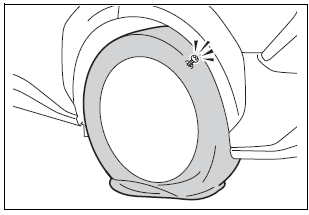
A flat tire that cannot be repaired with the emergency tire puncture repair kit
In the following cases, the tire cannot be repaired with the emergency tire puncture repair kit. Contact your Toyota dealer.
- When the tire is damaged due to driving without sufficient air pressure
- When there are any cracks or damage at any location on the tire, such as on the side wall, except the tread
- When the tire is visibly separated from the wheel
- When the cut or damage to the tread is 0.16 in. (4 mm) long or more
- When the wheel is damaged
- When two or more tires have been punctured
- When more than one sharp objects such as nails or screws have passed through the tread on a single tire
Location of the emergency tire puncture repair kit and tools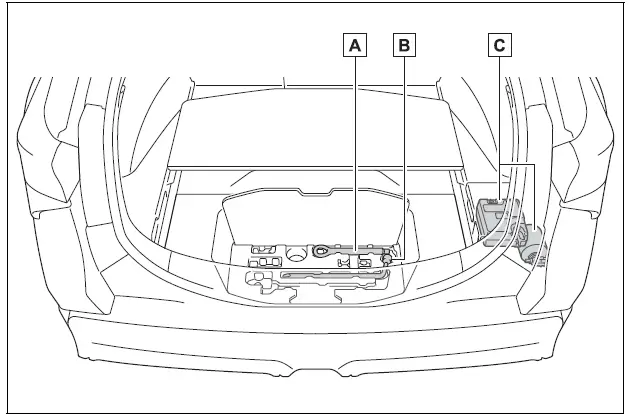
- Towing eyelet
- Wheel bolt wrench
- Emergency tire puncture repair kit
Emergency tire puncture repair kit components.
Bottle
Compressor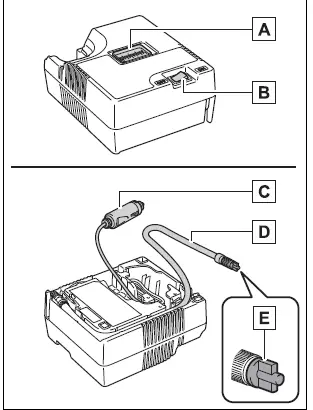
- A Air pressure gauge
- B Compressor switch
- C Power plug
- D Hose
- E Air release cap
Emergency tire puncture repair kit
- The sealant stored in the emergency tire puncture repair kit can be used only once to temporarily repair a single tire. If the sealant in the bottle and other parts of the kit have been used and need to be replaced, contact your Toyota dealer.
- The compressor can be used repeatedly.
- The sealant can be used when the outside temperature is from -40°F (-40°C) to 140°F (60°C).
- The kit is exclusively designed for size and type of tires originally installed on your vehicle. Do not use it for tires that a different size than the original ones, or for any other purposes.
- If the sealant gets on your clothes, it may stain
- If the sealant adheres to a wheel or the surface of the vehicle body, the stain may not be removable if it is not cleaned at once. Immediately wipe away the sealant with a wet cloth.
- During operation of the repair kit, a loud operation noise is produced. This does not indicate a malfunction.
- Do not use to check or to adjust the tire pressure.
- Note for checking the emergency tire puncture repair kit
- Check the sealant expiry date occasionally. The expiry date is shown on the bottle.
- Do not use sealant whose expiry date has already passed. Otherwise, repairs conducted using the emergency tire puncture repair kit may not be performed properly.
- The sealant has a limited life span. The expiry date is marked on the bottle. The sealant should be replaced before the expiry date. Contact your Toyota dealer for replacement
WARNING
- If you have a flat tire Driving even a short distance with a flat tire can damage the tire and the wheel beyond repair.
- Driving with a flat tire may cause a circumferential groove on the side wall. In such a case, the tire may explode when using a repair kit.
- Caution while driving
- Store the repair kit in the luggage compartment. Injuries may result in the event of an accident or sudden braking.
- The repair kit is exclusively only for your vehicle. Do not use repair kit on other vehicles, which could lead to an accident causing death or serious injury.
- Do not use repair kit for tires that are different size than the original ones, or for any other purpose. If the tires have not been completely repaired, it could lead to an accident causing death or serious injury.
- Precautions for use of the sealant
- Ingesting the sealant is hazardous to your health. If you ingest sealant, consume as much water as possible, then immediately consult a doctor.
- If sealant gets in eyes or adheres to skin, immediately wash it off with water. If discomfort persists, consult a doctor.
Taking out the emergency tire puncture repair kit
-
-
- Open the deck board.

- Remove the cover.

- Open the deck board.
- Take out the emergency tire puncture repair kit.

- Compressor
- Bottle.
-
Emergency repair procedure
- Take out the repair kit from the plastic bag.
- Remove the hose and take out the power plug from the compressor
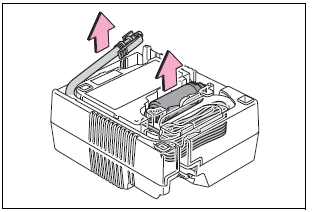
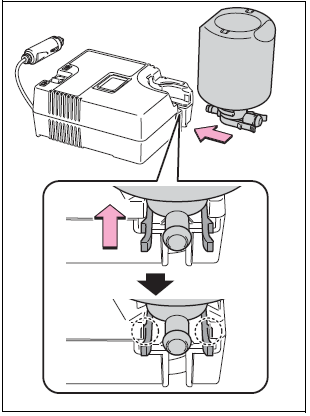
- Connect the bottle to the compressor.
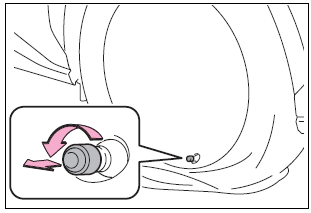
- Remove the valve cap from the valve of the punctured tire.
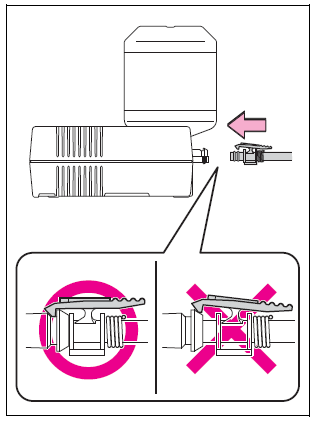
- Extend the hose. Remove the air release cap from the hose.

- Connect the hose to the valve.
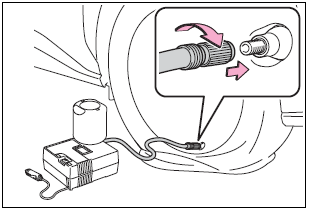
- Make sure that the compressor switch is off.

- Connect the power plug to the power outlet socket.
- Attach the sticker provided with the tire puncture repair kit to a position easily seen from the driver’s seat.

- Check the specified tire inflation pressure.
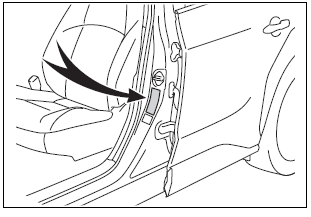
- Start the EV system.
- To inject the sealant and inflate the tire, turn the compressor switch on.
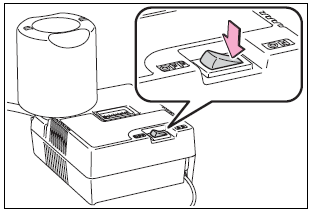
- Inflate the tire until the recommended pressure is reached.
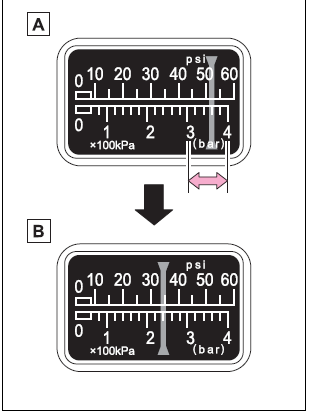
- The sealant will be injected and the pressure will spike to between 44 psi (300 kPa, 3.0 kgf/cm2 or bar) and 58 psi (400 kPa, 4.0 kgf/cm2 or bar), then gradually decrease.
- The air pressure gauge will display the actual tire inflation pressure about 1 to 5 minutes after the switch is turned on.
- Turn the compressor switch off and then check the tire inflation pressure. Being careful not to over inflate, check and repeat the inflation procedure until the specified tire inflation pressure is reached.
- The tire can be inflated for about 5 to 20 minutes (depending on the outside temperature). If the tire inflation pressure is still lower than the specified point after inflation for 25 minutes, the tire is too damaged to be repaired. Turn the compressor switch off and contact your Toyota dealer.
- If the tire inflation pressure exceeds the specified air pressure, let out some air to adjust the tire inflation pressure.
- With the compressor switch off, pull out the power plug from the power outlet socket and then disconnect the hose from the valve on the tire. Some sealant may leak when the hose is removed.
- Install the valve cap onto the valve of the emergency repaired tire.
- Attach the air release cap to the end of the hose. If the air release cap is not attached, the sealant may leak and the vehicle may get dirty.
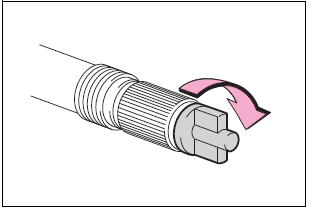
- Temporarily store the bottle in the luggage compartment while it is connected to the compressor.
- To spread the liquid sealant evenly within the tire, immediately drive safely for about 3 miles (5 km) below 50 mph (80 km/h).
- After driving, stop your vehicle in a safe place on a hard, flat surface and reconnect the repair kit

- Turn the compressor switch on and wait for several seconds, then turn it off. Check the tire inflation pressure.
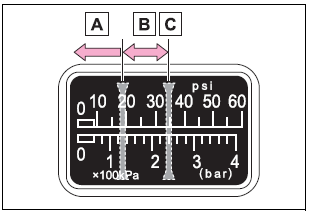
- If the tire inflation pressure is under 19 psi (130 kPa, 1.3 kgf/cm2 or bar):
- The puncture cannot be repaired. Contact your Toyota dealer.
- If the tire inflation pressure is 19 psi (130 kPa, 1.3 kgf/cm2 or bar) or higher, but less than the specified air pressure: Proceed to step 22.
- If the tire inflation pressure is the specified air pressure: Proceed to step23.
- Turn the compressor switch on to inflate the tire until the specified air pressure is reached. Drive for about 3 miles (5 km) and then perform step 20. 23Attach the air release cap to the end of the hose.
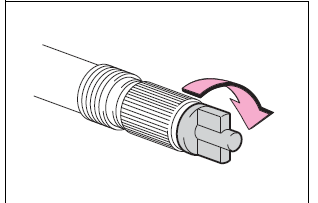
- Store the bottle in the luggage compartment while it is connected to the compressor.
- Taking precautions to avoid sudden braking, sudden acceleration and sharp turns, drive carefully at under 50 mph (80 km/h) to the nearest Toyota dealer that is less than 62 miles (100 km) away for tire repair or replacement
If the tire is inflated to more than the specified air pressure
- Disconnect the hose from the valve.
- Install the air release cap to the end of the hose and push the protrusion on the air release cap into the valve to let some air out.

- Disconnect the hose from the valve, remove the air release cap from the hose and then reconnect the hose.
- Turn the compressor switch on and wait for several seconds, then turn it off. Check that the air pressure indicator shows the specified air pressure is reached.
After a tire is repaired with the emergency tire puncture repair kit
- The tire pressure warning valve and transmitter should be replaced
- Even if the tire inflation pressure is at the recommended level, the tire pressure warning light may come on/flash.
WARNING
- When fixing the flat tire
- Stop your vehicle in a safe and flat area.
- Do not touch the wheels or the area around the brakes immediately after the vehicle has been driven.
- After the vehicle has been driven, the wheels and the area around the brakes may be extremely hot.
- Touching these areas with hands, feet or other body parts may result in burns.
WARNING
- Connect the valve and hose securely with the tire installed on the vehicle. If the hose is not properly connected to the valve, air leakage may occur as sealant may be sprayed out.
- If the hose comes off the valve while inflating the tire, there is a risk that the hose will move abruptly due to air pressure.
- After inflation of the tire has been completed, the sealant may splatter when the hose is disconnected or some air is let out of the tire.
- Follow the operation procedure to repair the tire. If the procedure is not followed, the sealant may spray out.
- Keep back from the tire while it is being repaired, as there is a chance of it bursting while the repair operation is being performed. If you notice any cracks or deformation of the tire, turn off the compressor switch and stop the repair operation immediately.
- The repair kit may overheat if operated for a long period of time. Do not operate the compressor continuously for more than 40 minutes.
- Parts of the repair kit become hot during operation. Be careful handling the repair kit during and after operation.
- Do not touch the metal part connecting the bottle and the compressor. It will be extremely hot.
- Do not attach the vehicle speed warning sticker to an area other than the one indicated.
- If the sticker is attached to an area where an SRS airbag is located, such as the pad of the steering wheel, it may prevent the SRS air bag from operating properly.
- Driving to spread the liquid sealant evenly Observe the following precautions to reduce the risk of accidents.
- Failing to do so may result in a loss of vehicle control and cause death or serious injury.
- Drive the vehicle carefully at a low speed. Be especially careful when turning and cornering.
- If the vehicle does not drive straight or you feel a pull through the steering wheel, stop the vehicle and check the following:
- Tire condition. The tire may have separated from the wheel.
- Tire inflation pressure. If the tire inflation pressure is 19 psi (130 kPa, 1.3 kgf/cm2 or bar) or less, the tire may be severely damaged.
NOTICE
- Do not put the repair kit directly onto dusty ground such as sand at the side of the road. If the repair kit vacuums up dust, etc., a malfunction may occur.
- Make sure the sealant bottle of the repair kit is in a vertical position. The repair kit does not operate properly when it is laid.
- Precautions for the emergency tire puncture repair kit
- The repair kit power source should be 12 V DC suitable for vehicle use. Do not connect the repair kit to any other source.
- Place the repair kit in a storage to prevent it from being exposed to dirt or water.
- Store the repair kit in the luggage compartment out of reach of children.
- Do not disassemble or modify the repair kit. Do not subject parts such as the air pressure indicator to impacts. This may cause a malfunction.
- To avoid damage to the tire pressure warning valves and transmitters When a tire is repaired with liquid sealants, the tire pressure warning valve and transmitter may not operate properly.
- If a liquid sealant is used, contact your Toyota dealer or other qualified service shop as soon as possible. After use of liquid sealant, make sure to replace the tire pressure warning valve and transmitter when repairing or replacing the tire.
If the EV system will not start
Reasons for the hybrid system not starting vary depending on the situation. Check the following and perform the appropriate procedure: The hybrid system will not start even though the correct starting procedure is being followed.
- The charging cable may be connected to the vehicle.
- The electronic key may not be functioning properly.*
- The traction battery may be completely discharged. Charge the traction battery.
- There may be a malfunction in the immobilizer system.*
- There may be a malfunction in the shift control system.*
- The EV system may be malfunctioning due to an electrical problem such as electronic key battery depletion or a blown fuse. However, depending on the type of malfunction, an interim measure is available to start the EV system. (
- There is a possibility that the temperature of the traction battery is extremely low (approximately below -22°F [- 30°C]). It may not be possible to shift the shift position from P
The interior lights and headlights are dim, or the horn does not sound or sounds at a low volume
- One of the following may be the cause of the problem:
- The 12-volt battery may be discharged.
- The 12-volt battery terminal connections may be loose or corroded.
The interior lights and headlights do not turn on, or the horn does not sound.
- One of the following may be the cause of the problem:
- The 12-volt battery may be discharged.
- One or both of the 12-volt battery terminals may be disconnected
- Contact your Toyota dealer if the problem cannot be repaired, or if repair procedures are unknown.
Starting the EV system in an emergency
When the EV system does not start, the following steps can be used as an interim measure to start the EV system if the power switch is functioning normally. Do not use this starting procedure except in cases of emergency.
- Set the parking brake
- Turn the power switch to ACC.
- Press and hold the power switch for about 15 seconds while depressing the brake pedal firmly.
After pressing the power switch for a while, a message regarding 12-volt battery control will be displayed, however continuing to press the switch. Even if the EV system can be started using the above steps, the system may be malfunctioning. Have the vehicle inspected by your Toyota dealer. The setting can be customized.
If you lose your keys
New genuine keys can be made by your Toyota dealer using the other key and the key number stamped on your key number plate. Keep the plate in a safe place such as your wallet, not in the vehicle.
NOTICE
When an electronic key is lost If the electronic key remains lost, the risk of vehicle theft increases significantly. Visit your Toyota dealer immediately with all remaining electronic keys that were provided with your vehicle.
If the electronic key does not operate properly
If communication between the electronic key and vehicle is interrupted or the electronic key cannot be used because the battery is depleted, the smart key system and wireless remote control cannot be used. In such cases, the doors can be opened and the EV system can be started by following the procedure below.
When the electronic key does not work properly
- Make sure that the smart key system has not been deactivated in the customization setting. If it is off, turn the function on.
- Check if the battery-saving mode is set. If it is set, cancel the function.
NOTICE
In case of a smart key system malfunction, or other key-related problems Take your vehicle with all the electronic keys provided with your vehicle to your Toyota dealer
Locking and unlocking the doors
Use the mechanical key in order to perform the following operations.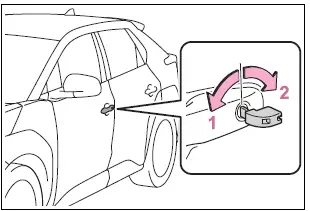
- Locks all the doors
- Unlocks the door
Key linked functions
- Closes the windows (turn and hold)*
- Opens the windows (turn and hold)*
- These settings must be customized at your Toyota dealer.

WARNING
When using the mechanical key and operating the power windows Operate the power window after checking to make sure that there is no possibility of any passenger having any of their body parts caught in the window. Also, do not allow children to operate the mechanical key. It is possible for children and other passengers to get caught in the power window
Starting the EV system
- Depress the brake pedal.
- Touch the electronic key to the power switch
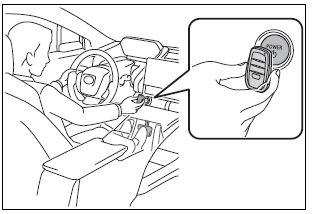
- Firmly depress the brake pedal and check that
 is displayed on the multi-information display.
is displayed on the multi-information display. - Press the power switch shortly and firmly.
Stopping the EV system
Shift the shift position to P, set the parking brake and press the power switch as you normally do when stopping the EV system.
Replacing the key battery
As the above procedure is a temporary measure, it is recommended that the electronic key battery be replaced immediately when the battery is depleted
Alarm
If a door is unlocked using the mechanical key when the alarm system is set, the alarm may be triggered.
Changing power switch modes
Release the brake pedal and press the power switch in step 3 above. The EV system does not start and modes will be changed each time the switch is pressed.
If the 12-volt battery is discharged
The following procedures may be used to start the EV system if the vehicle’s 12- volt battery is discharged. You can also call your Toyota dealer or a qualified repair shop.
Restarting the EV system
- Confirm that the electronic key is being carried. When connecting the jumper (or booster) cables, depending on the situation, the alarm may activate and doors locked.
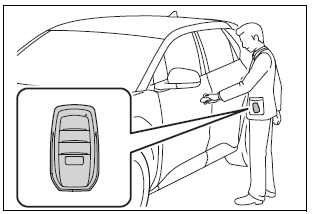
- Open the hood
- Open the positive (+) battery terminal cover

- Connect a positive jumper cable clamp to on your vehicle and connect the clamp on the other end of the positive cable to the second vehicle. Then, connect a negative cable clamp to on the second vehicle and connect the clamp at the other end of the negative cable to
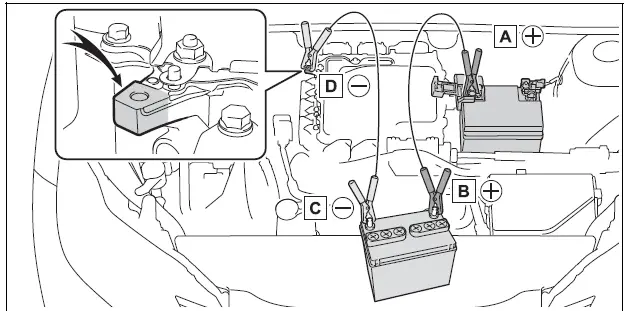
- Positive (+) battery terminal (your vehicle)
- Positive (+) battery terminal (second vehicle)
- Negative (-) battery terminal (second vehicle)
- Solid, stationary, unpainted metallic point away from the battery and any moving parts as shown in the illustration
- Start the engine of the second vehicle. Increase the engine speed slightly and maintain at that level for approximately 5 minutes to recharge the 12-volt battery of your vehicle.
- Open and close any of the doors of your vehicle with the power switch OFF.
- Maintain the engine speed of the second vehicle and start the EV system of your vehicle by turning the power switch to ON.
- Make sure the “READY” indicator comes on. If the indicator light does not come on, contact your Toyota dealer.
- Once the EV system has started, remove the jumper cables in the exact reverse order from which they were connected.
- Close the positive (+) battery terminal cover. Once the EV system starts, have the vehicle inspected at your Toyota dealer as soon as possible.
Starting the EV system when the 12-volt battery is discharged
The EV system cannot be started by push-starting.
To prevent 12-volt battery discharge
Turn off the headlights, the air conditioning system, the audio system, etc. while the EV system is off.
Turn off any unnecessary electrical components when the vehicle is running at a low speed for an extended period, such as in heavy traffic.
Charging the 12-volt battery
The electricity stored in the 12-volt battery will discharge gradually even when the vehicle is not in use, due to natural discharge and the draining effects of certain electrical appliances. If the vehicle is left for a long time, the 12-volt battery may discharge, and the EV system may be unable to start. (The 12-volt battery recharges automatically while the EV system is operating.)
When the 12-volt battery is removed or discharged
- Information stored in the ECU is cleared. When the 12-volt battery is depleted, have the vehicle inspected at your Toyota dealer.
- In some cases, it may not be possible to unlock the doors using the smart key system when the 12- volt battery is discharged. Use the wireless remote control or the mechanical key to lock or unlock the doors.
- The EV system may not start on the first attempt after the 12-volt battery has recharged but will start normally after the second attempt. This is not a malfunction.
- The power switch mode is memorized by the vehicle. When the 12- volt battery is reconnected, the system will return to the mode it was in before the 12-volt battery was discharged. Before disconnecting the 12-volt battery, turn the power switch off. If you are unsure what mode the power switch was in before the 12-volt battery discharged, be especially careful when reconnecting the 12-volt battery.
- If the 12-volt battery discharges, it may not be possible to shift the shift position to other positions. In this case, the vehicle cannot be towed without lifting both front wheels because the front wheels will be locked.
- The power back door (if equipped) must be initialized.
When replacing the 12-volt battery
- Use a 12-volt battery that conforms to European regulations.
- Use a 12-volt battery the case size is same as the previous one (LN1), 20 hour rate capacity (20HR) is equivalent (45Ah) or greater, and a performance rating (CCA) is equivalent (286A) or greater. • If the sizes differ, the 12-volt battery cannot be properly secured.
- If an improper 12-volt battery is used, battery performance may decrease and the EV system may not be able to restart.
- If the 20 hour rate capacity is low, even if the time period where the vehicle is not used is a short time, the 12-volt battery may discharge and EV system may not be able to start. For details, consult your Toyota dealer.
WARNING
When removing the 12-volt battery terminals
Always remove the negative (-) terminal first. If the positive (+) terminal contacts any metal in the surrounding area when the positive (+) terminal is removed, a spark may occur, leading to a fire in addition to electrical shocks and death or serious injury.
Avoiding 12-volt battery fires or explosions
Observe the following precautions to prevent accidentally igniting the flammable gas that may be emitted from the 12-volt battery:
- Make sure each jumper cable is connected to the correct terminal and that it is not unintentionally in contact with any other than the intended terminal.
- Do not allow the other end of the jumper cable connected to the “+” terminal to come into contact with any other parts or metal surfaces in the area, such as brackets or unpainted metal.
- Do not allow the + and – clamps of the jumper cables to come into contact with each other.
- Do not smoke, use matches, or cigarette lighters or allow open flame near the 12-volt battery.
12-volt battery precautions
The 12-volt battery contains poisonous and corrosive acidic electrolytes, while related parts contain lead and lead compounds. Observe the following precautions when handling the 12-volt battery:
- When working with the 12-volt battery, always wear safety glasses and take care not to allow any battery fluids (acid) to come into contact with skin, clothing or the vehicle body.
- Do not lean over the 12-volt battery.
- In the event that battery fluid comes into contact with the skin or eyes, immediately wash the affected area with water and seek medical attention. Place a wet sponge or cloth over the affected area until medical attention can be received.
- Always wash your hands after handling the 12-volt battery support, terminals, and other 12-volt battery-related parts.
- Do not allow children near the 12-volt battery
WARNING
When replacing the 12-volt battery
After replacing, securely attach the exhaust hose and exhaust hole plug to the exhaust hole of the replaced 12-volt battery. If not properly installed, gases (hydrogen) may leak into the vehicle interior, and there is the possible danger of the gas igniting and exploding.
NOTICE
When handling jumper cables
When connecting the jumper cables, ensure that they do not become entangled in the cooling fan or engine drive belt.
To prevent damaging the vehicle
The exclusive jump-starting terminal is to be used when charging the 12-volt battery from another vehicle in an emergency. It cannot be used to jump start another vehicle.
If your vehicle overheats
When “EV System overheated Output power reduced” is shown on the multi-information display, your vehicle may be overheating.
NOTICE
Cooling system coolant The radiator coolant is exclusive for radiator usage. Damage may occur when water or any other type of coolant is used, so never use any other fluid. When there is no “Toyota Genuine Traction Battery Coolant”, immediately contact your Toyota dealer.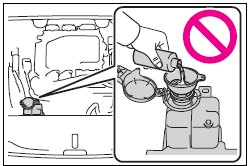
Correction procedures
- Stop the vehicle in a safe place and turn off the air conditioning system.
- Leave the EV system operating and carefully lift the hood.
- Check if the cooling fan is operating.
- After the EV system has cooled down, inspect the hoses and radiator core (radiator) for any leaks.
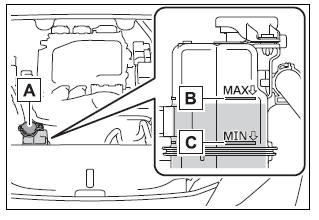
- Radiator
- Cooling fan
- The coolant level is satisfactory if it is between the “MAX” and “MIN” lines on the reservoir.
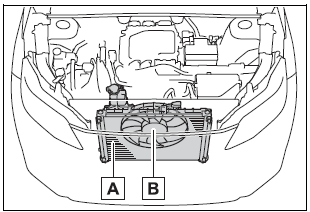
- Reservoir
- “MAX” line
- “MIN” line
- If the coolant is insufficient, replenish with “Toyota Genuine Traction Battery Coolant
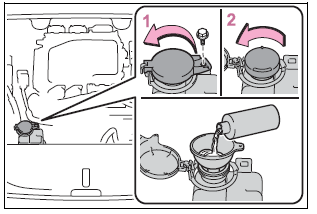
- Remove the bolt.
- Open the reservoir cap
WARNING
- To prevent an accident or injury when inspecting under the hood of your vehicle Observe the following precautions.
- Failure to do so may result in serious injury such as burns.
- If steam is seen coming from under the hood, do not open the hood until the steam has subsided.
- The motor compartment may be very hot.
WARNING
- Keep hands and clothing (especially a tie, a scarf or a muffler) away from the fan.
- Failure to do so may cause the hands or clothing to be caught, resulting in serious injury.
- Do not loosen the coolant reservoir cap while the EV system and radiator are hot. High-temperature steam or coolant could spray out.
NOTICE
- When adding coolant Add coolant slowly after the EV system has cooled down sufficiently. Adding cool coolant to a hot EV system too quickly can cause damage to the EV system.
- To prevent damage to the cooling system Observe the following precautions:
- Avoid contaminating the coolant with foreign matter (such as sand or dust, etc.).
- Do not use water or any other coolant when refilling coolant. Also, do not use any additive agents for the coolant.
If the vehicle becomes stuck
Carry out the following procedures if the tires spin or the vehicle becomes stuck in mud, dirt or snow:
Recovering procedure
- Stop the hybrid system. Set the parking brake and shift the shift lever to P.
- Remove the mud, snow or sand from around the front wheels.
- Place wood, stones or some other material under the front wheels to help provide traction.
- Restart the hybrid system.
- Shift the shift lever to D or R and release the parking brake. Then, while exercising caution, depress the accelerator pedal
When it is difficult to free the vehicle
Press to turn off TRAC
WARNING
- When attempting to free a stuck vehicle
If you choose to push the vehicle back and forth to free it, make sure the surrounding area is clear to avoid striking other vehicles, objects or people. The vehicle may also lunge forward or lunge back suddenly as it becomes free. Use extreme caution. - When shifting the shift lever
Be careful not to shift the shift lever with the accelerator pedal depressed. This may lead to unexpected rapid acceleration of the vehicle that may cause an accident resulting in death or serious injury.
NOTICE
- To avoid damaging the transmission and other components
- Avoid spinning the wheels and depressing the accelerator pedal more than necessary.
- If the vehicle remains stuck even after these procedures are performed, the vehicle may require towing to be freed.
- When a warning message for the automatic transmission fluid temperature is displayed while attempting to free a stuck vehicle, immediately remove your foot from the accelerator pedal and wait until the warning message disappears. Otherwise, the transmission may become damaged.
Q&A
What is the Toyota BZ4X 2023?
The Toyota BZ4X 2023 is an electric crossover SUV that is set to be released in the US market in 2022.
What is the driving range of the Toyota BZ4X?
The driving range of the Toyota BZ4X is estimated to be around 250 miles on a single charge.
How long does it take to charge the Toyota BZ4X?
The Toyota BZ4X can be charged up to 80% in just 40 minutes with a fast charger, while a full charge using a standard charger can take up to 8 hours.
What safety features does the Toyota BZ4X have?
The Toyota BZ4X comes with advanced safety features such as lane departure warning, adaptive cruise control, automatic emergency braking, and blind spot monitoring.
What is the seating capacity of the Toyota BZ4X?
The Toyota BZ4X has a seating capacity of five passengers.
What is the price range of the Toyota BZ4X?
The price range for the Toyota BZ4X is not yet announced, but it is expected to be competitive with other electric SUVs in the market.
How does the Toyota BZ4X handle in snowy or icy conditions?
The Toyota BZ4X comes with an all-wheel drive system that helps it handle well in snowy or icy conditions.
Can the Toyota BZ4X be driven off-road?
The Toyota BZ4X is not specifically designed for off-road driving, but its all-wheel-drive system and high ground clearance make it capable of light off-road driving.
What should I do if I run out of charge while driving the Toyota BZ4X?
If you run out of charge while driving the Toyota BZ4X, pull over to a safe location, turn off the vehicle, and contact Toyota’s roadside assistance for help.
How can I locate a charging station for my Toyota BZ4X?
The Toyota BZ4X comes with a navigation system that can help you locate nearby charging stations.
What should I do if I am in an accident while driving the Toyota BZ4X?
If you are in an accident while driving the Toyota BZ4X, first check for injuries and call for medical assistance if necessary. Then, contact the police and report the accident. You should also contact your insurance provider to report the incident.
What should I do if my Toyota BZ4X breaks down?
If your Toyota BZ4X breaks down, pull over to a safe location, turn off the vehicle, and contact Toyota’s roadside assistance for help.
How often does the Toyota BZ4X need to be serviced?
The Toyota BZ4X requires regular maintenance and servicing, which should be performed according to the manufacturer’s recommended schedule.
How do I access the emergency brake in the Toyota BZ4X?
The emergency brake in the Toyota BZ4X is a pedal located to the left of the brake pedal. To engage the emergency brake, push down on the pedal.
What should I do if my Toyota BZ4X starts to overheat?
If your Toyota BZ4X starts to overheat, turn off the air conditioning and pull over to a safe location. Allow the vehicle to cool down before attempting to drive it again, and contact Toyota’s roadside assistance for help if necessary.
Useful Link
2023 Toyota BZ4X Do-it-yourself maintenance Instructions
https://www.toyota.com/owners/resources/warranty-owners-manuals
Related Article
2023 Toyota Highlander Specs, Price, Features, and Mileage (Brochure)
2024 Toyota Camry Specs, Price, Features, and Mileage (Brochure)
2023 Toyota Corolla Hatchback Specs, Price, Features, and Mileage (Brochure)
2023 Toyota Tundra Specs, Price, Features and Mileage (Brochure)


